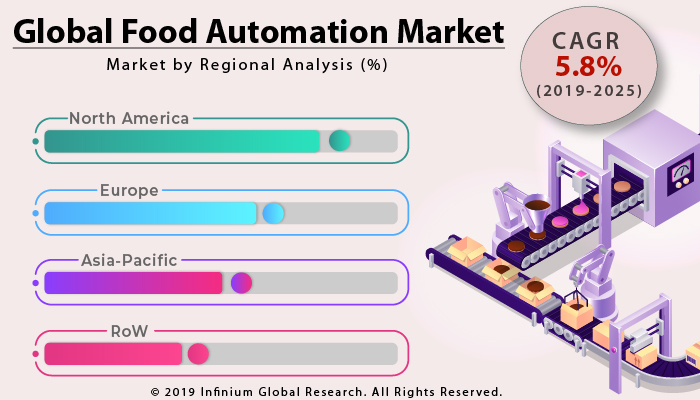Food Automation Market (Type - Motors & Generators, Motor Controls, Discrete Controller Systems & Visualization, Rotary & Linear Products, and Other Types; Function - Packaging & Re-packaging, Palletizing, Sorting & Grading, Picking & Placing, Processing, and Other Functions; Application - Dairy, Bakery, Beverage, Confectionery, Fruits & Vegetables, Meat, Poultry, and Seafood, and Other Applications): Global Industry Analysis, Trends, Size, Share and Forecasts to 2025
A recent report published by Infinium Global Research on
food automation market provides in-depth analysis of segments and sub-segments
in the global as well as regional food automation market. The study also
highlights the impact of drivers, restraints, and macro indicators on the
global and regional food automation market over the short term as well as long
term. The report is a comprehensive presentation of trends, forecast and dollar
values of the global food automation market. According to the report, the
global food automation market is projected to grow at a CAGR of 5.8% over the
forecast period of 2019-2025.
Market Insight
The automation in the food
industry helps the food processors to maintain the quality and appearance of
the final food products for the long term. This helps to minimize the
application of scarce resources like raw material, human labor, and raw
materials as compared to other processes. Further, the food products made from
the automation process are safer as compared to the manual process. The
automation process helps to maintain the prescribed standard of the final food
products easily, which is not possible through the manual or semi-manual
process. It helps the producers to improve the profit margin on products
offered for sale, and boost its brand image among the consumers. Moreover, it
helps to trace the raw material ingredients, which in turn improves the food
safety of the offered food products.
The continuous growing
competition among the food processing companies to provide food products at a
cheap cost is forcing them to adopt automation in their processing and other
allied activities of food processing. Further, the continuous increasing raw
material cost and labor wages are reducing the profit margin of the owners in
this labor-intensive manufacturing industry. Additionally, the growing focus
for the efficient use of scarce resources as water and the raw material is
motivating manufacturers to adopt automation in their business activities.
Additionally, the continuous growing demand for safe food, which has less human
intervention during processing, packaging among the millennial consumers is
catalyzing the growth of the food automation market. However, the cost factor
of modern food automation equipment is hampering the growth of the market.
Moreover, the growing demand for safe food products at a low price in the
developing countries are expected to boost demand in the near future.
In terms of region, North America
dominates the food automation market, owing to the presence of several leading
players, who are actively engaged in this business. Additionally, the presence
of a large number of food processing companies, fruits, and vegetable
processing companies, and the extensive presence of the fast-food retail chains
are continuously helping to grow the food automation market in this region.
Moreover, the Asia-Pacific is expected to grow at the highest CAGR during the
forecast period due to the growing demand for safe food products among the
young and middle-class consumers in the region.

Segment Covered
The report on the global food automation market covers segments
such as type, function, and application. On the basis of type, the sub-markets
include motors & generators, motor controls, discrete controller systems
& visualization, rotary & linear products, and other types. On the
basis of function, the sub-markets include packaging & re-packaging,
palletizing, sorting & grading, picking & placing, processing, and
other functions. On the basis of application, the sub-markets include dairy,
bakery, beverage, confectionery, fruits & vegetables, meat, poultry, and
seafood, and other applications.
Companies Profiled:
The report provides profiles of the companies in the market
such as Emerson Electric, Rexnord Industries, LLC, Yaskawa Electric
Corporation, Fortive, GEA Group, Schneider Electric, Yokogawa Electric, Siemens
AG, Rockwell Automation, Inc., and Mitsubishi Electric Corporation.
Report Highlights:
The report provides deep insights into the demand forecasts,
market trends, and micro and macro indicators. In addition, this report
provides insights into the factors that are driving and restraining the growth
in this market. Moreover, The IGR-Growth Matrix analysis given in the report
brings an insight into the investment areas that existing or new market players
can consider. The report provides insights into the market using analytical
tools such as Porter's five forces analysis and DRO analysis of food automation
market. Moreover, the study highlights current market trends and provides
forecast from 2019-2025. We also have highlighted future trends in the market
that will affect the demand during the forecast period. Moreover, the
competitive analysis given in each regional market brings an insight into the
market share of the leading players.
Please Choose One of them.